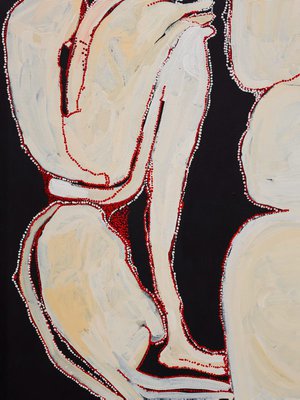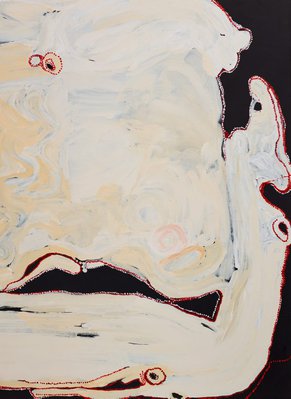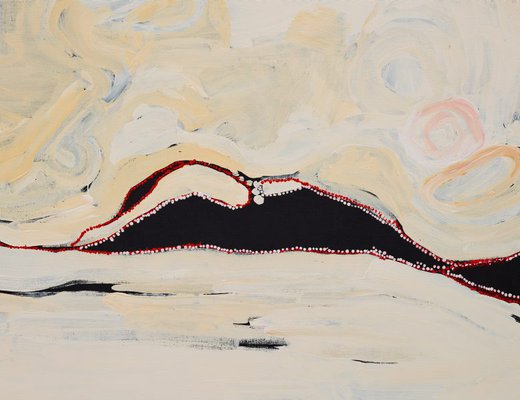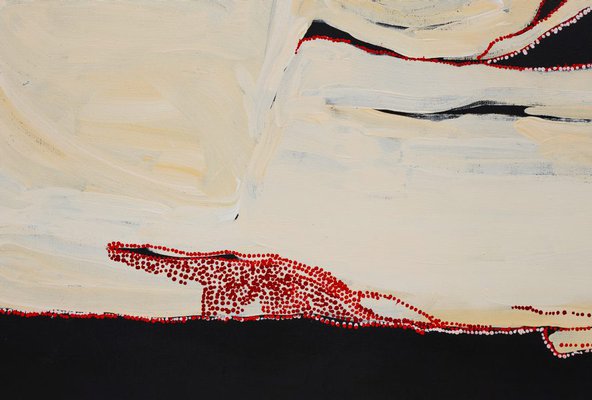Title
Tjitjiti
2015
Artist






-
Details
- Place where the work was made
-
Tjuntjuntjara
→
Great Victoria Desert
→
Western Australia
→
Australia
- Cultural origin
- Pitjantjatjara, Southern Desert region
- Date
- 2015
- Media category
- Painting
- Materials used
- acrylic on linen
- Dimensions
- 199.5 x 290.6 x 2.4 cm
- Signature & date
Not signed. Not dated.
- Credit
- Wendy Barron Bequest Fund 2016
- Location
- Not on display
- Accession number
- 50.2016
- Copyright
- © Carlene West/Copyright Agency
- Artist information
-
Carlene West
Works in the collection
- Share
-
-
About
Carlene West was born in southern Spinifex country at Tjitji and moved to the mission of Cundeelee as a teenager with her parents. This became home to many Spinifex people as they were forced off their country due to the British nuclear testing at Maralinga. At Cundeelee West married Fred Grant, and they became integral to the movement for a return to country. Art played a vital role in this process and West contributed to all of the women’s collaborative works that documented the innate connection the Spinifex people had to their country which were used as evidence in their Native title claim.
Throughout her painting career West has given form to Tjitjiti where she was born. In early works she represented this vast, elongated, salt lake ringed by tawny sandhills in the manner of the visual language of the Western Desert region, which has become synonymous with the artists of Papunya Tula. However, from around 2012 as West slipped into a gentle form of Alzheimer’s, she has given gestural form to the lake in textural brushwork of stark white, highlighted with cream and laced with traceries of fine red dotting, floating on a void of blackness.
Earlier works in this style were more structured, with more elaborate use of red and often the inclusion of sections of circular forms set amongst an organic field of dots. In her seminal work ‘Tjitjiti’ 2015 there is only the slightest presence of this detailing, as the form of the lake itself dominates the canvas, with expressive brushwork recalling the colours, form and presence of the lake, while demonstrating West’s enjoyment in the very act of mark making itself.The art cetnre provided the folowing information on this work:
Nyangatja ngayuku ngura ka ngura panya ini Tjitji ka Tjitjitiku Tjukurpa Minyma Kutjarangku tjtji kutju katinyi tjina wati Tjitjitinya ka nyara maliki Wati Kuninka altingu "tjitji kutju ngalya kati' ka panyaya wirtjapakanu ka watingku kulata wakani minyma kutjara tjungu ngaranyi iluntananyi tjitji kulu ngaltaltjara ka kuwari minyma kutjara nyupali tjitjiti ngaranyi.
This is a painting representing my country of Tjitjiti a large salt lake. It is the site of the ancestor women. Here the Two Women are walking across the big salt lake with a child when they are called by a stranger, a Quoll Man, to hand over the child. The women run to escape but the Quoll Man threw many spears and eventually one hit, impaling the two women together with the child. This is a sad story. The two women can still be seen today standing at Tjitjiti. In Spinifex lore Tjitjiti is highly sacred country and the place where Carlene was born. It is an area of unusual geographic features of a huge salt lake and large
un-vegetated sandhills. Like all Tjukurpa (creation stories) these ancestral beings create and shape this landscape as they travel through it. At Tjitjiti the Quoll Man throws many spears in the pursuit of the Two Women and the spears can today be seen as a rock seam protruding from the ground. The Two Women are outcrops that can be seen a great distance away. This Tjukurpa line and the characters involved continue moving to the east of Tjitjiti. The Quoll Man digs for water at Ooldea in the south and eventually fights the Moon Man in country near Oak Valley where he passes away. -
Exhibition history
Shown in 1 exhibition
Longing for Home, Art Gallery of New South Wales, Sydney, 06 Mar 2021–22 Aug 2021

